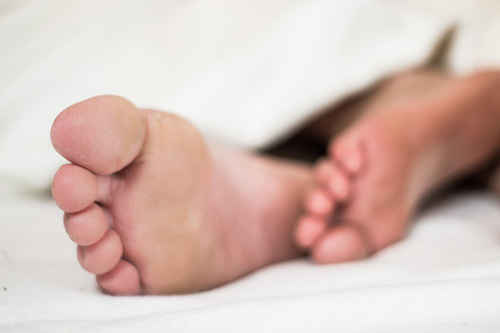Unnormal blood sugar levels result in skin problems that manifest as dryness, troublesome flaking and hypersensitivity. Particularly prone to change is the skin of the feet, which is initially rough and unpleasant to the touch, but over time diabetic lesions can develop on the legs. The skin of diabetics is more prone to injury, and its regeneration process is markedly delayed.
There are a number of pathological changes in the blood vessels, muscles, nerves, skin, leading to infections, ulceration and tissue destruction. Diabetic foot syndrome appears slightly earlier in type II diabetes than in type I. It is accompanied by gradually increasing pain and tingling and muscle spasms. Diabetic foot is most often a combination of two varieties – ischemic and neuropathic. Underlying the neuropathic variety is a disorder of the innervation of the foot. This results in abnormal or complete loss of sensation of stimuli, redness and unnatural warming of the feet. This often leads to uncontrolled damage, resulting in ulcers that are difficult to heal. The skin becomes dry, almost waxy, numerous cracks and keratoses appear on them. Sensation in the sweat glands numerous on the feet is impaired. Due to poor innervation of the feet and legs, the motorics of gait is also altered, creating all kinds of foot deformities, i.e. calluses, corns, hallux valgus, clawed toenails, flat feet or hammer toes. The ischemic variety is associated with vascular degeneration, accompanied by a decrease in the amount of fatty tissue in the lower leg and the foot itself. Extensive hematomas form on the skin, leading to a change in its color. Through vascular damage, the skin becomes atrophied (the volume of tissue gradually decreases), there is loss of hair on the foot and ingrown nails.

The most important place should be given to proper prevention. At the very beginning, special attention should be paid to washing feet gently every day. Preparations with flax, hemp or potassium are perfect for this. Soaps with these ingredients perfectly cleanse the skin of the feet, but at the same time do not affect its barrier properties, cause the maintenance of the correct pH, and also have a moisturizing and lubricating effect on thin skin. In addition to thorough and gentle washing, it is worth twice a week to soak your feet in salt with magnesium, tea tree oil and laurel oil. Magnesium will reduce muscle spasms and laurel oil, through its deep moisturizing and lubricating effect, will nourish and work to rebuild the skin’s hydrolipid mantle. Tea tree oil will have an antibacterial and antifungal effect. After bathing, remember to dry your feet thoroughly so that no moisture is left in the interdigital space or on the sole. This can lead to the growth of fungi, and thus cause nail fungus – sole or skin between the toes. If fungal infection happens or some mechanical trauma occurs, the skin should be thoroughly disinfected, preferably with a preparation with active silver, then use an antifungal and astringent and anti-inflammatory preparation. Ingredients such as clove, which has a strong antibacterial and antifungal effect, sage, which has an anti-inflammatory and antiseptic effect, or hemp oil and andiroba, which, in addition to anti-inflammatory effects, strongly regenerate and strengthen the epidermis.

Once in a while you should take stronger care of the condition of the skin and toenails. Then, after bathing, it is worth gently using a natural pumice stone to pull off excess keratinized skin. After the procedure, the pumice stone should be washed in hot water and disinfected with a spirit-based preparation. Keep in mind that everyone should have their own pedicure utensils. It is best to file the nails gently with a glass file. It’s a good idea to apply a shea butter salt scrub to the whole feet and legs up to the knees and give them a gentle massage for about 5-7 minutes. After scrubbing, wash the feet under warm water, but not too hot, dry thoroughly, then apply an active product to the skin between the toes and nails, if necessary. Every day, preferably in the morning and evening, lubricate the feet with a cream containing urea and vegetable oils. Oils will moisturize the skin, and urea will gently exfoliate dead skin and cause deeper penetration of active substances.
If you have severe pain in the legs or are accompanied by other bone deformities, it is worth reaching for lotions that have an analgesic effect and strengthen the skeletal system, such as the Regenerating Lotion based on goose lard IWO MEDICA. The combination of such active substances as rosemary oil, castor oil and goose lard has analgesic, moisturizing and anti-rheumatic effects. It is worth applying several times a day.

In conclusion, in the care of diabetic foot syndrome, proper and systematic care has an important place. It must be gentle, but effective. So it is worth looking at natural cosmetics, which will slowly but most importantly safely improve the appearance of diabetic foot. Natural cosmetics will protect us from the penetration of unfriendly chemicals that weaken the body’s immunity. Their composition must also not contain irritants, which often aggravate the problem instead of fighting it.
How useful was this post?
Click on a star to rate it!
Average rating / 5. Vote count:
No votes so far! Be the first to rate this post.








